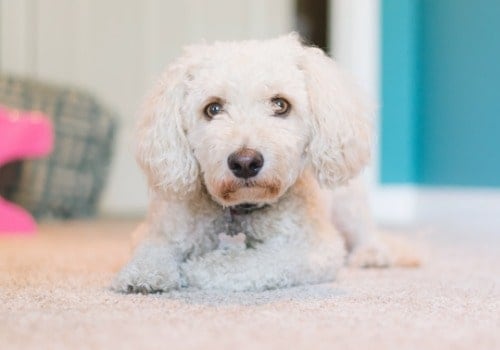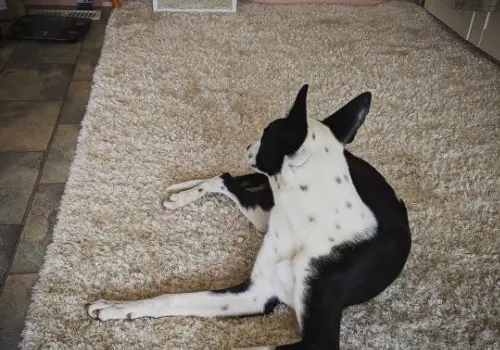Just when you think you’ve got your dog’s behavior perfected, he has to go and prove you wrong.
Today, the issue is particularly gross: he’s dragging his butt on the carpet. And the look on his face suggests he might even be enjoying it!
Nobody wants a dog’s butt and all the nasty things that come with it on their rug. But it doesn’t seem to be confined to one location, either.
The sidewalk, the grass, the garden… it seems there’s nowhere he’s not willing to scoot around.
But what does this behavior mean?
Is your dog dragging his butt for pleasure? Or is it a sign that something’s wrong with his rump?
And what can an exasperated dog owner do about it?
Let’s get to the bottom of this problem — read on!
The Darn-Scooting Truth

Butt dragging is commonly referred to as scooting, in reference to how it makes the dog look like he’s incrementally sliding along.
Whatever you call it, you probably fall into one of two camps: either you find it amusing or you find it annoying.
We have to admit, scooting does look pretty funny devoid of context. Perhaps it’s the novelty of it — we don’t usually see dogs moving in that way, or even in a vaguely similar way.
And we can certainly see how it can be frustrating, especially if you’ve got light-colored carpets or if your dog is a bit lacking in the hygiene department.
But the truth is that carpet scooting is almost always the result of a medical issue. It’s a way for your dog to try to relieve uncomfortable sensations in his posterior.
The issue, then, is figuring out just what’s wrong with your pup. Once that problem’s solved, he’ll no longer feel the need to drag his butt on your carpet — and you’ll both be utterly relieved!
Medical Conditions that Cause Butt Dragging
Good news: most of the medical causes for butt dragging or carpet scooting are easily resolved.
Bad news: there are quite a few of them, so you’ll need to figure out which one it is.
More good news: for the most part, these conditions have pretty distinct symptoms, making for easy diagnosis.
Anal Gland Issues

Just on the rim your dog’s bum are two small glands known as anal glands or anal sacs. These glands produce an oily substance that coats the dog’s poop as it comes out, making it easier to pass.
The oil is also extremely smelly, which is gross for us but highly informative for dogs. Hidden within that awful scent are cues to the dog’s age, health, sex and readiness to mate.
In this way, poop serves as a canine calling card, letting future passersby know who else has been there.
But sometimes, anal glands don’t empty out when they’re supposed to. The oil remains inside the glands, causing inflammation, pain, trouble defecating, excessive licking and, you guessed it, scooting.
Scooting is a dog’s attempt to relieve the discomfort of impacted anal glands. It may work in the short term, but over the long term, it can actually make it worse.
The excessive pressure and friction from scooting can cause small tears in the glands, leading to infection, abscess and even more pain. Because of this, early treatment is vital when your dog’s anal glands are impacted.
Treating Impacted Anal Glands

Thankfully, treatment is quick, usually painless and relatively affordable.
Your vet or your groomer can perform what’s called an “anal gland expression,” which involves massaging the glands until they expel the oil within them.
As you might expect, it’s an incredibly stinky procedure, so many owners prefer to have a professional handle it. But if you’re feeling brave, ask your vet or groomer to show you how to do it at home.
So if you notice your dog dragging his butt on the carpet, especially if he leaves behind a nasty mark or a smelly odor, have his anal glands checked out. They’re the most common cause of scooting by far, and they’re also among the easiest to
Matted Hair
Most dogs are pretty fastidious about the cleanliness of their nether regions. They’ll happily spend hours licking their butts clean, much to our disgust.
But overweight, elderly or mobility-impaired dogs often have trouble reaching back there to clean their hair. And breeds with long or textured hair who don’t get groomed regularly also experience issues with their rears.
The most common of these issues is matted hair.
Mats form when poop gets left behind in the hair as it passes. As it dries, it hardens, encasing the hair around it in a dense, tough mat.
Not only are mats gross, they can be extremely uncomfortable for dogs. The mats tug and yank the hair around them, which can lead to inflammation and further discomfort.
Your dog probably doesn’t know that his discomfort is due to mats. All he knows is that his butt doesn’t feel right, so he does what instinct tells him to do: scoot.
As with anal glands, though, mats and their associated irritation can be made worse by scooting. Scooting compacts the mats even further and the friction can cause even more swelling.
Treating Matted Hair
If you notice mats around your dog’s butt, a trip to the groomer’s is in order. A groomer will have the tools and expertise to safely remove the mats and return your dog’s hygiene to normal.
Regular grooming is necessary to prevent mats on long-haired dogs. But even short-haired dogs may require extra grooming if they’re unable to fully clean themselves.
Tapeworms and Other Parasites

Nobody likes tapeworms, but they’re everywhere nonetheless. They’re one of the most common canine parasites — and one of the most common causes of butt dragging.
You may notice the worms or their egg sacs, which look like grains of rice, in your dog’s stool. But you’ll probably notice the unstoppable scooting first, as tapeworms cause intense anal itching and pain.
Other tapeworm symptoms include increased appetite, weight loss, diarrhea, vomiting and lethargy.
Tapeworms aren’t the only parasite that can cause scooting. Microscopic bacteria like Giardia can infect your dog’s GI tract, resulting in severe itching, greenish diarrhea, vomiting and dehydration.
Treating Tapeworms and Other Parasites
If you suspect that internal parasites are causing your dog to drag his butt on the carpet, a trip to the vet is your next step. The vet will be able to run tests on your dog to determine which, if any, parasites are responsible.
Treatment will depend on the parasite. This is why it’s important for a vet to confirm the specific parasite before beginning any treatment.
Tapeworms, for instance, are usually treated with an antiparasitic medication called praziquantel. But Giardia is treated with antibiotics like metronidazole that aren’t effective on tapeworms.
Allergies

Be they seasonal or chronic, allergies are no fun for your dog.
Seasonal allergies come and go with the seasons, as pollen, dust and other irritants fill the air. But chronic allergies occur year-round, often due to fleas or certain food ingredients.
Whatever the cause, your dog’s allergies could be making him extremely itchy all over, not just on his butt. If you notice an increase in overall scratching in addition to butt dragging, allergies could be to blame.
Other canine allergy symptoms include inflammation, ear infections, hair loss, and decreased appetite.
Treating Allergies in Dogs
Seasonal allergies in dogs are usually diagnosed with a skin test. Tiny amounts of allergens are inserted just under the skin, which is then monitored for reactions.
Once diagnosed, seasonal allergies can be treated in many ways. Your vet may recommend antihistamines, steroids, antibiotics or omega-3 fatty acid supplements.
Other allergies, like food allergies, are trickier to diagnose. An elimination diet, in which various ingredients are changed, added or removed one at a time, can help to narrow down the exact cause.
Once the offending ingredient has been identified, cutting it out of your dog’s diet will alleviate the allergies. But if the cause can’t be determined, your vet may prescribe antihistamines to relieve the itching.
